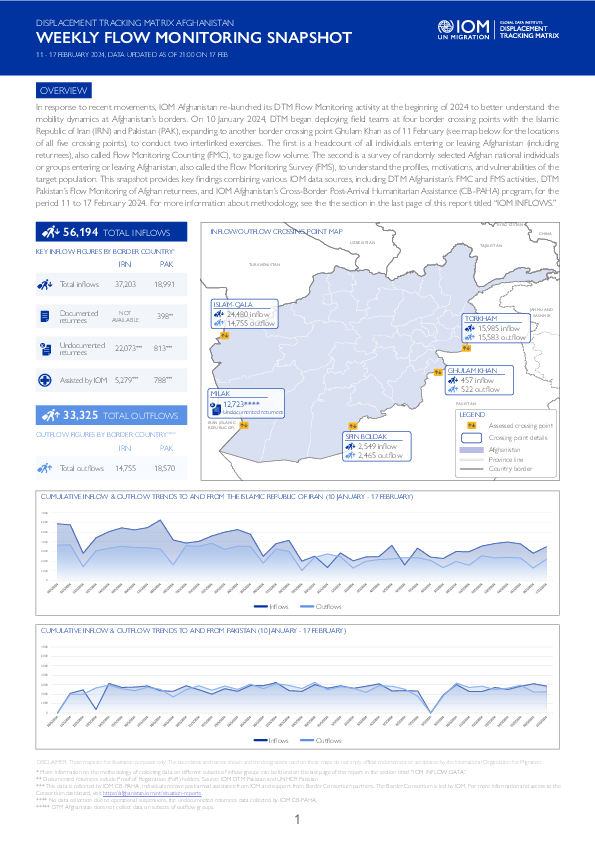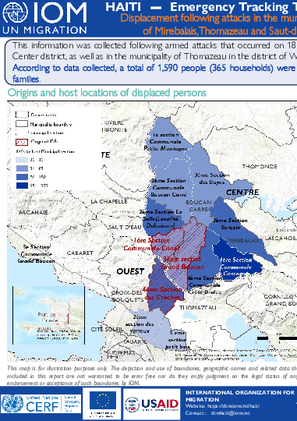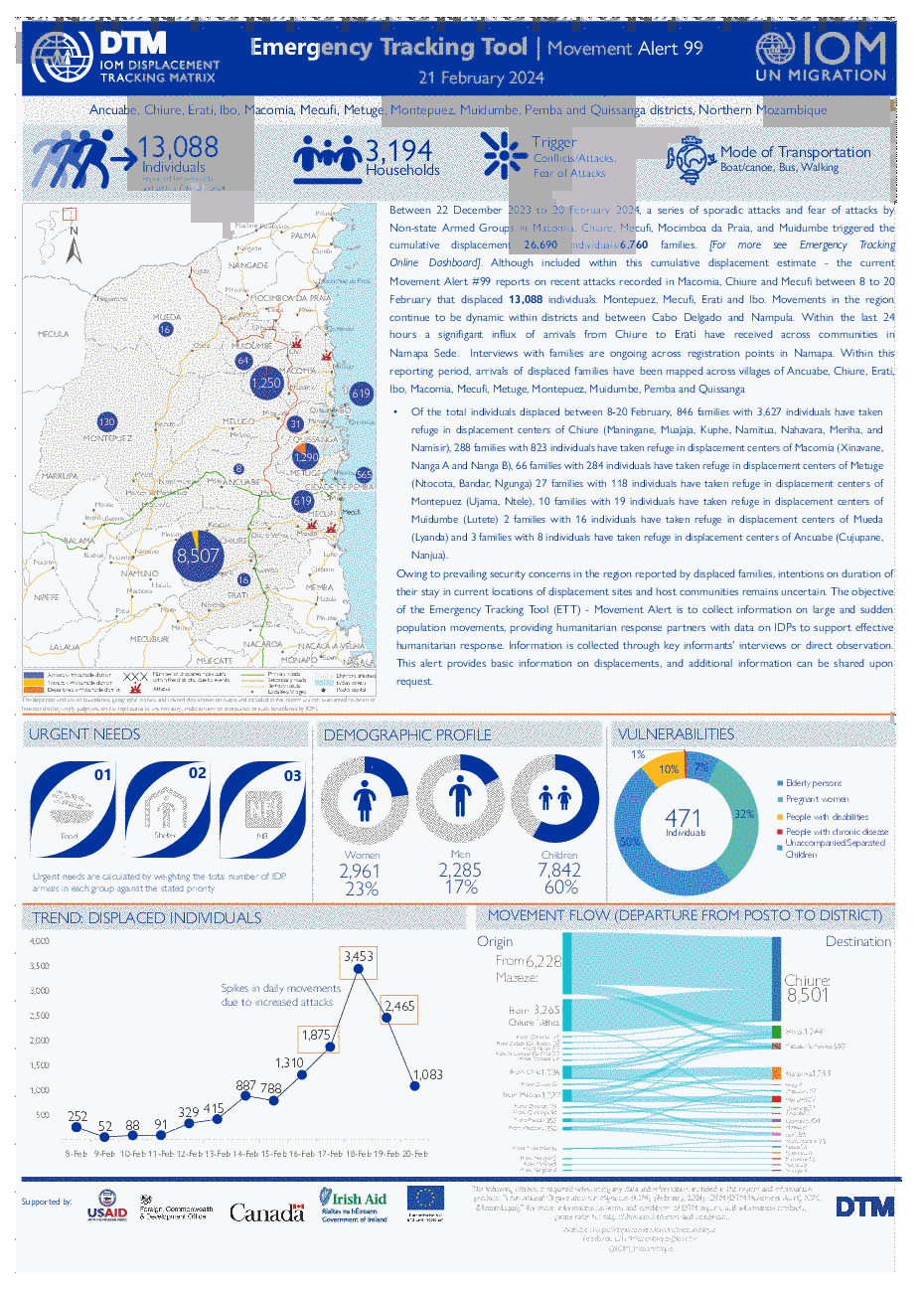-
Countries
-
Data and Analysis
-
Special Focus
-
Crisis Responses

Contact
DTMAfghanistan@iom.int
Language
English
Location
Afghanistan
Period Covered
Feb 11 2024
Feb 17 2024
Activity
- Survey
- Flow Monitoring Survey
- Flow Monitoring
In response to recent movements, IOM Afghanistan re-launched its DTM Flow Monitoring activity at the beginning of 2024 to better understand the mobility dynamics at Afghanistan’s borders. On 10 January 2024, DTM began deploying field teams at four border crossing points with the Islamic Republic of Iran (IRN) and Pakistan (PAK), expanding to another border crossing point Ghulam Khan as of 11 February (see map below for the locations of all five crossing points), to conduct two interlinked exercises. The first is a headcount of all individuals entering or leaving Afghanistan (including returnees), also called Flow Monitoring Counting (FMC), to gauge flow volume. The second is a survey of randomly selected Afghan national individuals or groups entering or leaving Afghanistan, also called the Flow Monitoring Survey (FMS), to understand the profiles, motivations, and vulnerabilities of the target population. This snapshot provides key findings combining various IOM data sources, including DTM Afghanistan’s FMC and FMS activities, DTM Pakistan’s Flow Monitoring of Afghan returnees, and IOM Afghanistan’s Cross-Border Post-Arrival Humanitarian Assistance (CB-PAHA) program, for the period 11 to 17 February 2024. For more information about methodology, see the the section in the last page of this report titled “IOM INFLOWS.”

Contact
DTM Libya, DTMLibya@iom.int
Language
English
Location
Libya
Period Covered
Oct 01 2023
Dec 30 2023
Activity
- Flow Monitoring
- Migrants presence
- Mobility Tracking
- Baseline Assessment
IOM Libya’s Displacement Tracking Matrix (DTM) programme identified a total of 706,509 migrants from 45 nationalities in the 100 Libyan municipalities during round 50 of data collection (October - December 2023). The number of migrants in Libya increased slightly compared to the previous round of data collection (from 697,532 migrants, round 49 to 706,509 migrants, round 50).
Despite improvement in the overall migrant unemployment rate, around half of female migrants continue to be unemployed and actively seeking work (49%) — more than three times the percentage of males (14%). At the same time, financial issues continue to be the main difficulties faced by the majority of migrants, regardless of sex or age. DTM Libya data further shows that economic constraints are the main obstacle impeding migrants’ access to essential services including healthcare, clean drinking water and education for their children.
Contact
dtmlibya@iom.int
Location
Libya
Activity
- Mobility Tracking
- Baseline Assessment
Period Covered
Oct 01 2023 -Dec 31 2023
Libya Migrants baseline assessment
Population Groups
Migrants Present
Survey Methodology
Unit of Analysis Or Observation
Admin Area 3
Admin Area 4
Type of Survey or Assessment
Key Informant
Keywords
Geographical Scope Full Coverage
Administrative boundaries with available data
The current dataset covers the following administrative boundaries

Contact
dtmhaiti@iom.int
Language
English
Location
Haiti
Period Covered
Feb 19 2024
Feb 20 2024
Activity
- Mobility Tracking
- Event Tracking
This information was collected following armed attacks that occurred on 18 February 2024 in the municipalities of Mirebalais and Saut-d’Eau located in the Center district, as well as in the municipality of Thomazeau in the district of West. According to data collected, a total of 1,590 people (365 households) were displaced following these attacks. All of them took refuge with relatives, in host families.
Contact
DTM Sudan, DTMSudan@iom.int
Location
Sudan
Activity
- Mobility Tracking
- Baseline Assessment
Period Covered
Apr 15 2021 -Feb 14 2024
- DTM Sudan estimates that 6,270,676 Individuals (1,249,695 Households) were recently internally displaced.
- The IDP caseload was observed in 6,771 locations across all of Sudan’s 18 states.
- The highest proportions of IDPs were observed across South Darfur (12%), River Nile (11%), East Darfur (11%), White Nile (8%), North Darfur (7%), Sennar (7%), Central Darfur (7%), Gedaref (6%), Northern (6%), and Aj Jazirah (6%).
- Field teams reported that the IDPs were originally displaced from twelve states. As reported, 57% per cent of IDPs were displaced from Khartoum state (3,545,909 IDPs), followed by South Darfur (15%), North Darfur (8%), Aj Jazirah (7%), Central Darfur (5%), West Darfur (4%), East Darfur (1%), and South Kordofan (1%).
- IOM-DTM also reported that an estimated 1,870,422 mixed cross-border movements were made into neighbouring countries.
- This product provides brief insights into those displaced in Sudan post-15 April 2023. For more granular information on the IDP caseload and the displacement context, please see IOM-DTM's Monthly Displacement Overview (05).
A more detailed version of this dataset is available, to get access kindly click on the 'Request Access' button
Population Groups
IDPs
Survey Methodology
Unit of Analysis Or Observation
Site or Location
Type of Survey or Assessment
Key Informant
Keywords
Geographical Scope Partial Coverage
Administrative boundaries with available data
The current dataset covers the following administrative boundaries

Contact
DTMUkraine@iom.int
Language
English
Location
Ukraine
Period Covered
Nov 01 2023
Dec 31 2023
Activity
- Return Intention
- Mobility Tracking
As of 27 December 2023, IOM estimates that around 3,689,000 people remained internally displaced in Ukraine1 while UNHCR indicates that further 5,974,800 people were displaced abroad. As the war continues, large numbers of displaced have returned home. IOM estimates that, as of 27 December 2023, approximately 4,455,000 people have returned spontaneously to their place of habitual residence in Ukraine following a period of displacement of at least two weeks (internal displacement or cross-border). Of these, 26 per cent have returned from abroad.
To inform targeted interventions aimed at alleviating the vulnerability that stems from poor structural and social conditions in areas of return, the CoRA provides granular data on where returns are occurring, where those who have returned are most vulnerable and why.

Contact
DTMUkraine@iom.int
Language
English
Location
Ukraine
Period Covered
Nov 27 2023
Dec 12 2023
Activity
- Survey
Between 27 November and 27 December 2023, the International Organization for Migration (IOM) conducted Round 15 of the General Population Survey (GPS), a highly representative assessment of internal displacement and returns in Ukraine. Fifty data collection experts conducted the assessment screener phone-based interviews with 20,000 randomly selected respondents and follow-up interviews with 1,517 IDPs, 1,541 returnees, and 2,002 residents, using the Computer-Assisted Telephone Interview (CATI) methodology and a Random Digit Dial (RDD) approach.
This report provides the main findings from Round 15 of the GPS, including detailed insights into population figures, return movements and intentions, demographic profiles, household composition and vulnerabilities, and needs of the returnee population, to facilitate evidence-based decision-making on strategic, technical, and programmatic aspects of the response and recovery efforts in Ukraine.

Contact
DTMMozambique@iom.int
Language
English
Location
Mozambique
Period Covered
Feb 08 2024
Feb 20 2024
Activity
- Mobility Tracking
Between 22 December 2023 to 20 February 2024, a series of sporadic attacks and fear of attacks by Non-state Armed Groups in Macomia, Chiure, Mecufi, Mocimboa da Praia, and Muidumbe triggered the cumulative displacement 26,690 individuals/6,760 families. [For more see Emergency Tracking Online Dashboard]. Although included within this cumulative displacement estimate - the current Movement Alert #99 reports on recent attacks recorded in Macomia, Chiure and Mecufi between 8 to 20 February that displaced 13,088 individuals. Montepuez, Mecufi, Erati and Ibo. Movements in the region continue to be dynamic within districts and between Cabo Delgado and Nampula. Within the last 24 hours a significant influx of arrivals from Chiure to Nampula have received across communities in Namapa Sede. Interviews with families are ongoing across registration points in Namapa. Within this reporting period, arrivals of displaced families have been mapped across villages of Ancuabe, Chiure, Erati, Ibo, Macomia, Mecufi, Metuge, Montepuez, Muidumbe, Pemba and Quissanga.

Contact
DTM Burundi, DTMBurundi@iom.int
Language
French
Location
Burundi
Period Covered
Jan 28 2024
Feb 03 2024
Activity
- Mobility Tracking
- Event Tracking
La DTM a identifié 14,941 personnes affectées, dont 2,387 personnes déplacées par les pluies torrentielles, les vents violents et les glissements de terrain les provinces de Bujumbura Rural, Bujumbura Mairie, Bururi, Makamba, Muramvya, Mwaro, Rumonge, Rutana et Ruyigi

Contact
DTM Burundi, DTMBurundi@iom.int
Language
French
Location
Burundi
Period Covered
Feb 11 2024
Feb 18 2024
Activity
- Mobility Tracking
- Event Tracking
La DTM a identifié 5 214 personnes affectées, dont 1758 déplacées par les pluies torrentielles et les vents violents dans les provinces de Bururi, Makamba, Cibitoke et Muyinga.